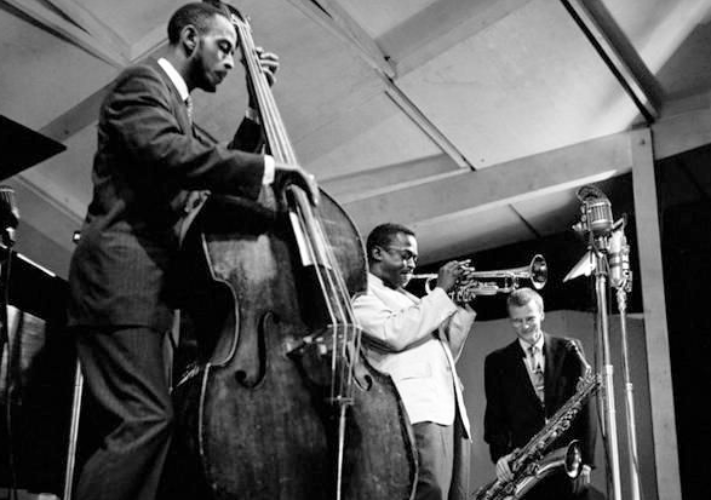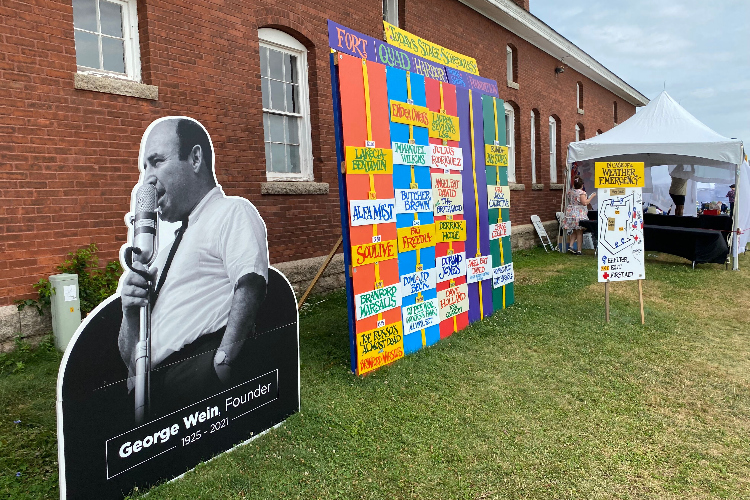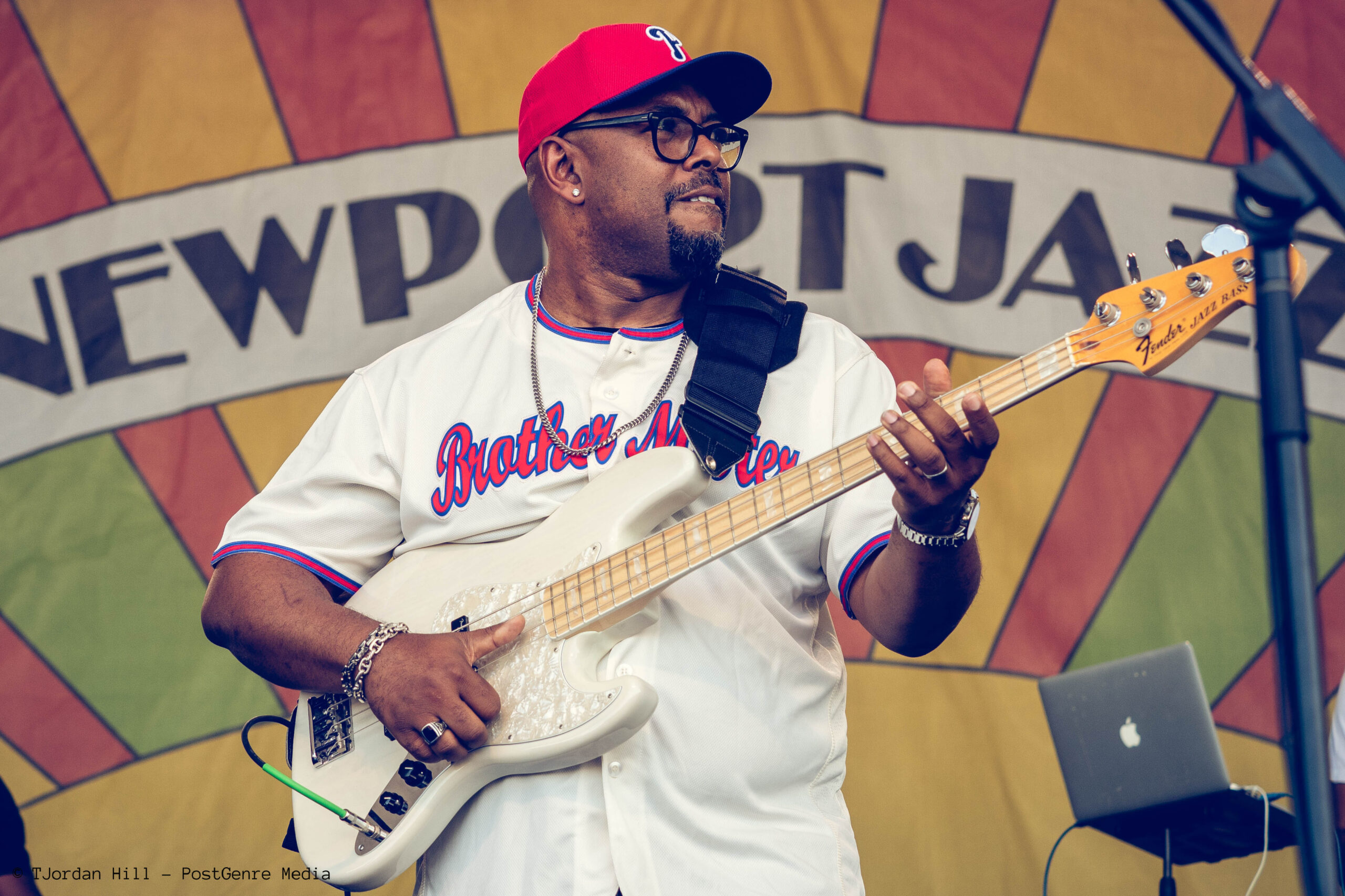A History of the Newport Jazz Festival – Chapter I: A New Tradition, 1954-1955
|
Getting your Trinity Audio player ready...
|
By 9:18 PM on the evening of July 17, 1954, Eddie Condon’s tribute to Dixieland finally began its delayed performance. Next was vocalist Lee Wiley, a jam session, and then a series of musicians who in hindsight left an indelible mark of music: the Modern Jazz Quartet with Horace Silver filling in for John Lewis, the Oscar Peterson Trio with Ray Brown and Herb Ellis, Billie Holiday, Dizzie Gillespie’s Quintet with Hank Mobley, and the Gerry Mulligan Quartet. Further elaborating on the collaborative nature of the music, the night’s performers joined in a massive jam session in which they delivered an empowered version of “I Got Rhythm.” It was well worth the $3 to $5 ticket price.
Later that evening, Louis and Elaine Lorillard hosted a gathering at their Quartrel mansion in which musicians mingled among Newport’s high society until the early morning. In addition to continuing the Festival’s work towards eradicating walls of social division, it set the stage for its annual gala, a tradition that continues. The gala has proven to be such a significant part of the Newport Jazz Festival that even in a year of shutdowns and social distancing, they are continuing the tradition online.
The next afternoon the Festival hosted its first of many lectures and discussions intended to emphasize the intellectual nature of the music. At the time, very few professionally studied the form. Moderated by Father Norman O’Connor, a Catholic priest who was on the foundation’s board and a frequent master of ceremonies in future years, professors Henry Cowell, Marshall Stearns, and Dr. Willis Laurence James discussed “The Place of Jazz in American Culture” intending to change the under-examination and largely succeeding in doing so. As literary scholar Robert O’Meally has noted, “In some ways, this explosion of academic interest in jazz can be traced back to that first panel in Newport…” Stearns would later form the Institute of Jazz Studies, the largest and most comprehensive library and archives of jazz and jazz-related materials in the world.
During the lecture, the skies parted and it began to pour. This development could have resulted in the cancellation of the night’s outdoor performances but, instead, led Wein to adopt a “rain or shine” policy that continues today. Despite the weather, the audience flocked to experience a tribute to Count Basie featuring Lester Young and Buck Clayton, Oscar Peterson’s Trio, guitarist Johnnie Smith, Dizzie Gillespie, trombonist Bill Harris, George Shearing’s Quintet, the Erroll Garner Trio, Lennie Tristano with Lee Konitz, Gene Krupa’s Trio, Ella Fitzgerald, and a jam session with them all. Even with the inclement weather on the second evening, the first Festival was a massive success. The front page of the New York Times featured the preceding weekend’s festivities in Newport and many other publications followed suit. The board of Newport Jazz Festival, Inc. quickly began work on the next year’s event.
In some ways, initial triumphs made planning for a follow-up difficult as the Newport Casino prohibited the use of their grounds because the crowds were too big for the venue. In response, Louis Lorillard purchased the Belcourt mansion as the Festival’s new home. Objections from some residents, however, made the city remove this option only weeks before opening night.* In desperation, the board turned to Freebody Park, a space near the Newport Casino.
During the nineteenth century, Freebody Park was the home of an octagonal-shaped open-air theater that hosted vaudeville acts then later movies. After the edifice burnt down in the 1910s, the city replaced it with a recreational field that played a critical role in the development of baseball in Newport. And by the 1930s, a still-standing stonewall was built around its perimeter.
The Festival expanded to three evenings; but like its predecessor, presented a wide range of styles. On Friday, July 15, the audience heard Erroll Garner, Woody Herman, Roy Eldridge with Coleman Hawkins, and Louis Armstrong. The next evening it was Marian McPartland’s Trio, Dinah Washington, Chet Baker’s Quartet (with special guest Gerry Mulligan), Lee Konitz and Warne Marsh, and Dave Brubeck.
The Max Roach-Clifford Brown Quintet also performed. Expectations ran high as some hoped the drummer and trumpeter would shape the future of music as Gillespie and Parker had done in the decade prior. Their smoldering set alongside tenor saxophonist Harold Land, pianist Richie Powell and bassist George Morrow showed that these expectations were not misplaced. Sadly, while Roach would remain a prominent figure, those aspirations never came to full fruition for Brown as he would die in a car accident the following summer at age 25.
Saturday night also presented George Wein’s All-Stars. In addition to being an adept concert promoter, Wein has always been a talented pianist and his performances would be present at many of Newport’s future Festivals. This particular one, featuring “Wild” Bill Davison, Buzzy Drootin, Vick Dickenson, Pee Wee Russell, Milt Hinton, and Gerry Mulligan purveyed traditional tunes including “When the Saints Go Marchin’ In” and “Royal Garden Blues.”
On July 17, Duke Ellington emceed the evening with musicians including the Modern Jazz Quartet, Lester Young with Joe Jones and Buck Clayton, Count Basie, and Gerry Mulligan.
And there was the performance that changed the course of modern music. Miles Davis, only recently clean from his heroin addiction and lacking a working band at the time, had approached Wein insisting that he should perform at the Festival. While the concert producer was initially reticent, many critics had written the trumpeter off entirely.
But Wein took a risk and placed Miles on the bill at the last moment. Wedged between sets by Count Basie and Dave Brubeck, Miles staged a surprise set with Thelonious Monk, Zoot Sims, Gerry Mulligan, Percy Heath, and Connie Kay. After the up-tempo Monk composition “Hackensack” the trumpeter placed the bell of his horn right up to a microphone. Out came a tone that balanced light and dark, one which was shimmering yet difficult to perceive. It fit the underlying composition “‘Round Midnight” perfectly. The set concluded with a version of “Now’s the Time” penned by the recently departed brilliant Charlie Parker.
The audience was so impressed by the performance that it completely changed the course of Davis’ career. As he later recounted in his autobiography, “[w]hen I got off the bandstand, everybody was looking at me like I was a king or something – people were running up to me offering me record deals. All the musicians there were treating me like I was a god… It was something else, man, looking out at all those people and then seeing them suddenly standing up and applauding what I had done.” Perhaps most importantly, it led George Avakian to sign him to Columbia Records. Davis would stay with the label for the next almost thirty years producing some of the greatest albums ever made.
*Belcourt was still used by the Festival for various workshops and receptions.
The Clifford Brown-Max Roach Quintet’s 1955 performance will be broadcast by WBGO on Friday, July 24, 2020 at 11PM EST and again on Saturday, July 25, at 6PM EST as part of Christian McBride’s Jazz Night in America.
It is also available on demand.
Significant portions of this chapter were adapted from George Wein’s autobiography (written with Nate Chinen) ‘Myself Among Others’ (Da Capo Press, 2004), ‘50: The Newport Jazz Festival, 1954-2004’, and Miles: The Autobiography by Miles Davis (with Quincy Troupe) (Simon & Schuster, 1990).



